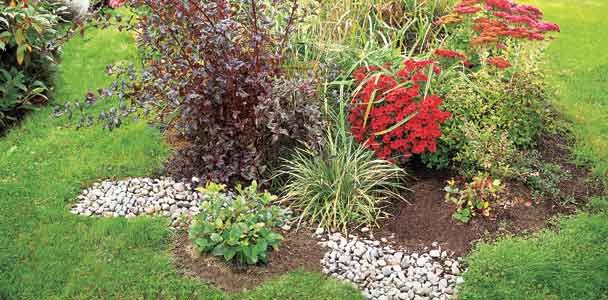We may be compensated if you purchase through links on our website. Our team is committed to delivering honest, objective, and independent reviews on home products and services.
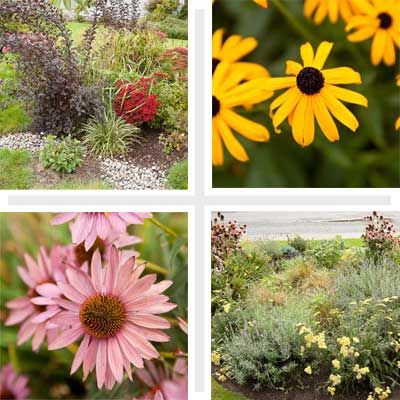
Are you looking to do your part to protect our waterways from pollution? Many homeowners use rain gardens to manage stormwater runoff and support their local ecosystems. If you’re interested in using rain gardens to keep waterways pollution-free, read on. We’ll tell you how rain gardens work, their benefits, and how you can create one in your own yard.
What Is a Rain Garden?
Unlike traditional gardens, rain gardens are landscape depressions that collect rainwater from roofs, driveways, and other surfaces and filter it before it makes its way into streams and rivers. The plants in a rain garden are usually native species that can tolerate both wet and dry conditions. This process not only helps prevent flooding and erosion but also removes pollutants from the water before it reaches natural waterways.
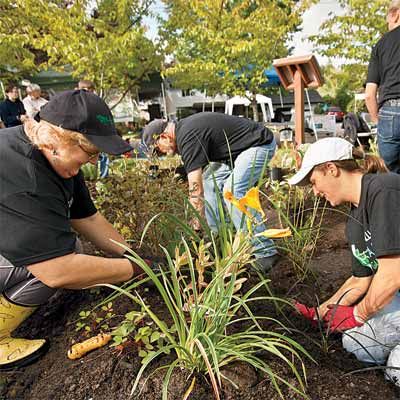
The Environmental Benefits of Rain Gardens
Rain gardens provide several environmental advantages, which eco-conscious homeowners and communities appreciate. Here are a few rain garden benefits.
Filtering Pollutants
When it rains, the rainwater collects many pollutants, such as pesticides, fertilizers, oil, and sediment. The rainwater and those toxins usually flow into natural waterways, such as rivers and lakes, but rain gardens trap those pollutants before they can make their way to the waterways and harm aquatic life. The plants and soil then filter and break down those contaminants. This process helps to improve the water in nearby streams, rivers, and lakes—supporting healthy ecosystems.
Reducing Erosion
Stormwater runoff causes soil erosion, which can reduce soil fertility and make it harder to grow plants and food. A rain garden can slow erosion by capturing and slowing the stormwater’s flow. When it rains heavily, the garden absorbs the excess water and helps to maintain the landscape’s integrity.
Recharging Groundwater
The water deep in the ground and on the surface balance each other out. If the landscape is covered by an impervious surface, such as a driveway, it can’t absorb rainwater and reduces the groundwater. There is even more of a groundwater deficit if a community accesses the underground aquifers for drinking water. If the groundwater is depleted, wells run dry, sinkholes form, and the water quality deteriorates. Rain gardens recharge groundwater because they slow the water’s flow into the soil, replenishing the underground aquifers instead of washing it away.
How a Rain Garden Works
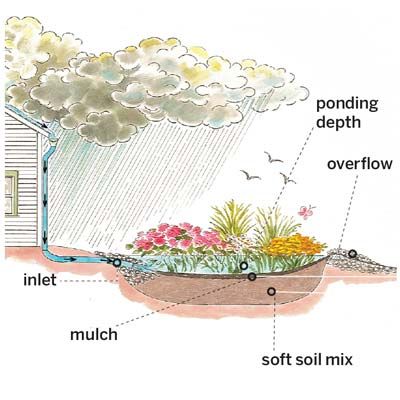
Now that you know a rain garden’s benefits, we’ll share what a rain garden consists of and how the infiltration process works. These details will help you plan your own rain garden.
Key Components of a Rain Garden
Here are the parts of a well-designed rain garden:
- Basin: The shallow depression that holds water temporarily when it rains
- Inlet: This is where stormwater enters the garden from a downspout, surface runoff, etc.
- Mulch: A layer of organic material that helps retain moisture and prevent erosion
- Native plants: Type of plants that have adapted to local conditions and can tolerate both wet and dry periods
- Soil mixture: A blend of native soil, sand, and compost that encourages water infiltration and supports plant growth
The Filtration Process
When it rains, water flows into the rain garden from the inlet. The basin holds the water as the soil below slowly absorbs it. As the water works its way through the ground, the soil filters pollutants that microorganisms break down.
Native plant roots act like channels in the ground, which work well to filter water and provide a habitat for beneficial microorganisms. These plants also absorb excess nutrients to purify the water so that it’s clean when it enters the groundwater or nearby waterways.
Designing Your Rain Garden
There are several factors you’ll want to consider when you create your rain garden, such as its location. Below we’ll cover a few tips.
Choosing the Right Location
With the right location, your rain garden will thrive. Here are some guidelines to follow:
- Avoid areas with high water tables or existing drainage problems.
- Choose a spot that receives runoff from dense surfaces.
- Make sure the area has good sun exposure to support plant growth.
- Place the garden at least 10 feet away from building foundations to prevent water damage.
Selecting Appropriate Plants
Many gardeners choose native plants because they’re accustomed to local conditions and don’t require a lot of maintenance. When you’re picking out your rain garden plants:
- Choose a mix of plants that can tolerate both wet and dry conditions.
- Keep in mind that your plants will grow, so consider how much space you have to accommodate their full size.
- Pick out plants with different heights, textures, and bloom times for visual interest.
- Select plants that attract pollinators and beneficial insects.
Considering Soil Conditions
Your plant-growing success depends on your soil conditions. If you aren’t sure what type of soil you have, you can test it. This will help you figure out its chemical profile to identify any potential issues, such as drainage problems or nutritional deficiencies. Once you have the results, you can amend the soil to improve its structure and fertility.
Zones in Your Rain Garden
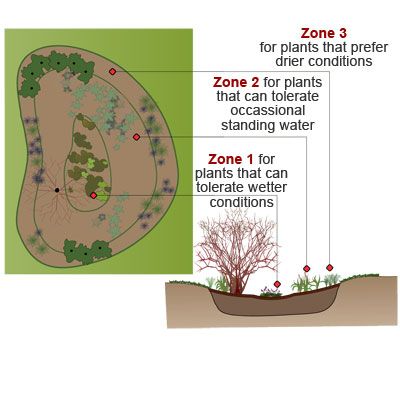
Think of a rain garden as areas of varying degrees of moisture within the same bed. Since the outer edges of a rain garden dry out faster than the center, plants that work well in the middle might not do as well along the perimeter. You can see this illustrated in the diagram above. Here’s a quick breakdown:
- Zone 1: It’s wettest in the rain garden’s center, so you need plants that thrive even in mucky soil
- Zone 2: Surrounding Zone 1, put plants that can tolerate occasional standing water
- Zone 3: Plants for the edges and berm should prefer drier conditions because they seldom stay under water very long
Types of Rain Garden Plants
Rain-garden plants should survive dry seasons without irrigation, so your options may include native plants that grow near seasonal wetlands in your area. Using locally native plants also eliminates worries about introducing invasive plants, a particular issue with rain gardens because the growing conditions are ideal for many species.
If you’ve started looking into which native plants to add to your rain garden, you may be overwhelmed by all the possibilities. There are a lot of options, so we’ve included suggestions below to help you narrow your choices.
Ornamental Grasses
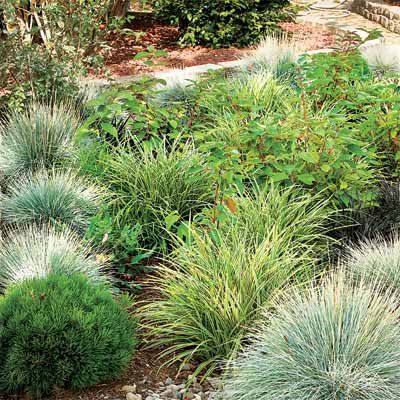
These grasses are low-maintenance, provide erosion control, and can tolerate heavy rains and drought conditions, so they are common plants in rain gardens. Some options include:
- Blue fescue (Festuca ovina var. glauca)
- Blue aat grass (Helictotrichon sempervirens)
- Tufted hair grass (Deschampsia cespitosa)
Here is the plant list for the green rain garden below:
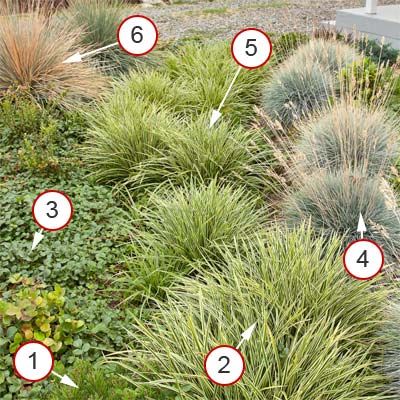
1. Mugo pine
2. ‘Ice Dance’ Japanese sedge
3. Coastal or beach strawberry
4. Blue fescue
5. Tufted hair grass
6. Blue oat grass
Perennials
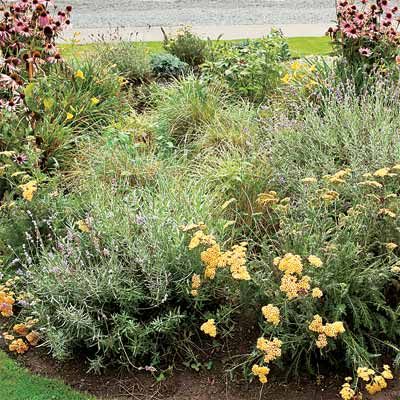
Hardy perennials have long-lasting blooms and can live in both wet and dry conditions. They also add color to your space and attract pollinators. Some popular choices include:
- ‘Autumn Joy’ sedum (Sedum ‘Herbstfreude’)
- Black-eyed Susan (Rudbeckia fulgida)
- Purple coneflower (Echinacea purpurea)
We’ve included a list of some perennials pictured below:
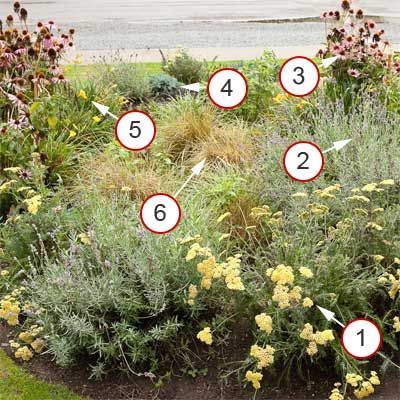
1. ‘Moonshine’ yarrow
2. ‘Hidcote’ English lavender
3. Purple coneflower
4. ‘Blue Star’ juniper
5. ‘Stella de Oro’ daylily
6. Tufted hair grass
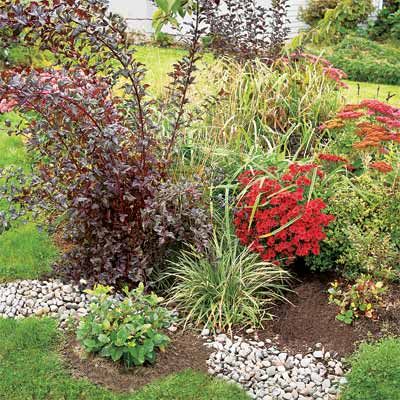
Shrubs
Some shrubs have foliage and flowers—some even provide some visual interest in the winter. Here are a few shrubs that can add structure and year-round interest to your rain garden:
- Evergreen huckleberry (Vaccinium ovatum)
- Ninebark (Physocarpus opulifolius)
- Red-twig dogwood (Cornus sericea)
Groundcovers
Groundcovers grow low to the ground to create a dense mat to help maintain soil moisture and reduce the risk of weed growth. If you have some bare ground in your rain garden, you can use groundcovers to reduce erosion and provide a habitat for beneficial insects. A few options include:
- Bearberry (Arctostaphylos uva-ursi)
- Creeping Jenny (Lysimachia nummularia)
- Sweet woodruff (Galium odoratum)
Aquatic Plants
As we mentioned earlier, Zone 1 is the wettest part of your rain garden. This is a spot where you can add aquatic plants. These plants are used to wet conditions and offer a unique look. They also filter the water because they absorb excess nutrients. Here are three you might want to use:
- Marsh marigold (Caltha palustris)
- Pickerelweed (Pontederia cordata)
- Water iris (Iris laevigata)
Below, we’ve included a few more plant lists with photos so that you can get an idea of what they may look like in your rain garden.
Planting for Symmetry and Color
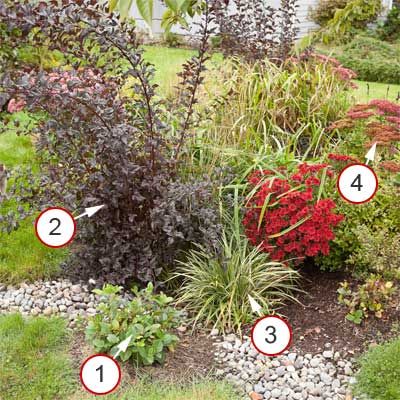
Anchored by a pair of matching shrubs at both ends and limited mostly to various shades of green and purple, this rain garden looks especially well-planned.
1. Salal
2. Pacific ninebark
3. ‘Ice Dance’ Japanese sedge
4. ‘Autumn Joy’ sedum
Easy-Care Grasses
In the rain gardens below, plant roots and the spongy soil absorb the water over the next day or two after a storm, and the water trickles into the surrounding earth.
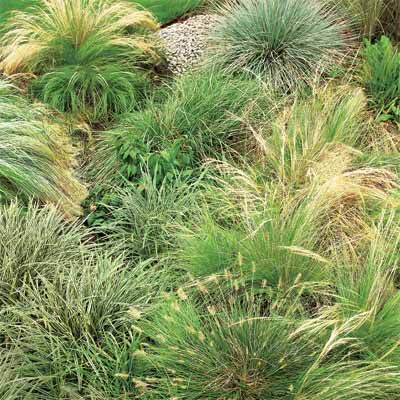
A variety of billowing, grasslike plants give this garden its calming look. In a breeze, the undulating blades almost look like gentle waves in the ocean. Here are some grasses that sway and move:
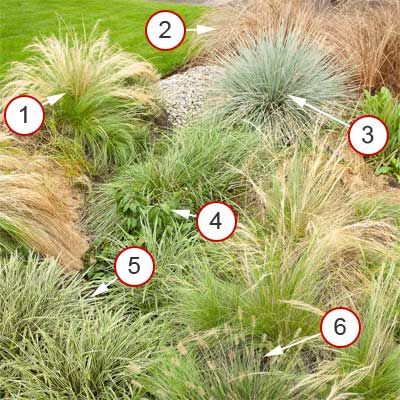
1. Mexican feather grass
2. Leather-leaf sedge
3. Blue oat grass
4. Kelsey dwarf dogwood
5. ‘Ice Dance’ Japanese sedge
6. ‘Little Bunny’ dwarf fountain grass
Curb Appeal With Colorful Flowers
This rain garden suits a dedicated gardener who loves flowers and is willing to clip back fading blooms so that the plants stay tidy.
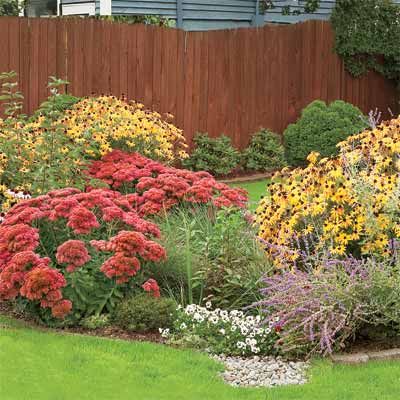
Below is the plant list for the flower-filled garden shown.
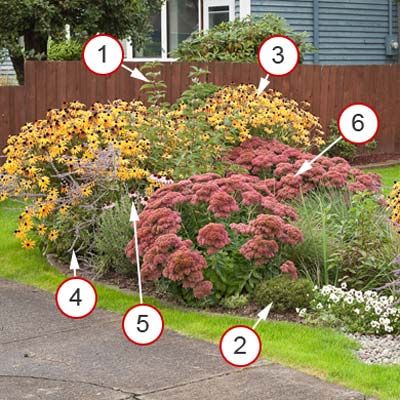
1. Red-twig Dogwood
2. Mugo pine
3. Black-eyed Susan
4. Russian sage
5. Purple coneflower
6. ‘Autumn Joy’ sedum
Ornamental Grasses to Accent a Home
Just as with a standard garden bed, a rain garden can emphasize a particular color.
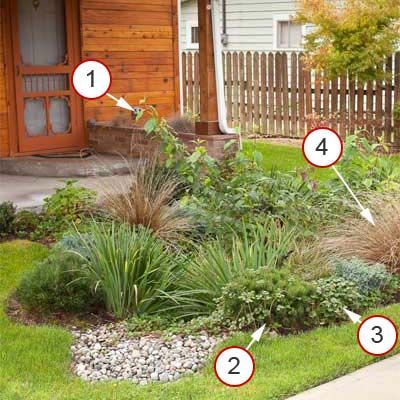
Here it’s the orange-brown of the house siding, accented by the white of the trim.
1. Red-twig dogwood
2. Mugo pine
3. Coastal or beach strawberry
4. Leather-leaf sedge
More No-Fuss, Neat, and Tidy Plants
This rain garden is all about looking fine with little care.
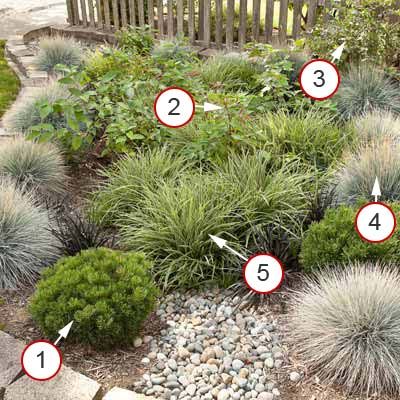
There are no flowers to clip or spent perennials to cut back, yet the garden still looks interesting because of the subtle color and texture variations.
1. Mugo pine
2. Red-twig dogwood
3. Snowberry
4. Blue fescue
5. ‘Ice Dance’ Japanese sedge
Building Your Rain Garden
We’ve covered design, but what about installing a rain garden? Here are the steps you need to take once you’ve found the right location, tested your soil, and picked out your plants.
Site Preparation
Prepare the location you’ve chosen for your rain garden. To do this:
- Mark the outline of your rain garden.
- Remove any existing grass or vegetation.
- Excavate the area to create a shallow basin, which should be 6–12 inches deep.
- Slope the sides to prevent erosion and make it look natural.
Soil Mixture
Create a soil mixture that promotes good drainage and plant growth. A typical blend consists of:
- 20-30% topsoil
- 20-30% compost
- 50-60% sand
Planting Techniques
When planting your rain garden:
- Arrange plants according to how they tolerate moisture. Remember to put your water-loving plants in Zone 1.
- Place your plants at the same depth as they were in their containers.
- Space plants considering their full size.
- Water thoroughly after you plant your garden and apply a 2–3 inch layer of mulch.
Maintaining Your Rain Garden
Properly maintaining your rain garden will help it to continue managing stormwater, and it will keep it looking as beautiful as when you first planted it. Here are some tips for caring for your rain garden:
Seasonal Care
Plants need different TLC according to the season. Below are the different steps you’ll want to take in the spring, summer, fall, and winter:
- Fall: Cut back perennials and remove fallen leaves.
- Spring: Remove dead plant material, add fresh mulch, and prune as needed.
- Summer: Water during dry periods and remove weeds regularly.
- Winter: Monitor for erosion and make any repairs.
Common Issues and Solutions
Even the most experienced gardeners run into problems from time to time. Here are some common ones you might have:
- Erosion: Add more plants or adjust the inlet to slow water flow.
- Plant die-off: Replace with plants that can better handle the conditions in your rain garden.
- Standing water: Improve drainage by adding more sand to the soil.
Monitoring Plant Health
Sometimes plants experience stress, disease, and pest infestations. If you detect these plant health problems early on, you can take swift action before it turns into a larger issue. Put into place integrated pest management practices, such as introducing beneficial insects or using organic treatments, to maintain plant health without harming the environment.
Rain Gardens for Different Climates
You can build a rain garden no matter the climate. Below we’ve explained the different options you have available in dry regions, temperate areas, and tropical locations.
Arid Regions
If you live in a dry climate, find drought-tolerant native plants and think about including a rock garden design to minimize water loss. Rocks and gravel can help hold soil moisture and reduce the need for irrigation. Consider using succulents and cacti that thrive in dry regions while adding visual interest.
Temperate Zones
Temperate regions offer the widest variety of plant options because you can use plants that can handle both wet and dry periods. Since there are seasonal changes in temperate climates, you can include a diverse range of plants that provide ecological benefits throughout the year.
Tropical Areas
Tropical regions get a lot of rainfall throughout the year. Plants in a tropical rain garden must withstand heavy rains, so choose native species that thrive in high humidity and moist conditions. You might even want to add some larger shrubs and trees to help manage increased water volume. Remember to prune your plants to prevent overcrowding.
Community Rain Garden Projects
Rain gardens are for more than just your home. They can have a significant impact when residents come together and implement one on a community scale. In this section, we’ll share how one community’s rain garden project was a success and what you can do to organize a garden in your neighborhood.
Case Study: Puyallup, Washington
In Puyallup, Washington, residents created a rain garden along two city blocks while protecting a local salmon stream. As community organizer Heidi Eshpeter explains, “It was a fabulous opportunity, too good to pass up. When you live near a salmon stream, everybody needs to do their part. “
Community volunteers had to install multiple rain gardens to capture and filter stormwater runoff. The gardens improved water quality in Clarks Creek but also made the neighborhood look pretty and attracted wildlife.
On a sunny day, dozens of neighbors in the western Washington town of Puyallup were out in their front yards, elbow-deep in dirt. They were planting a half-dozen saucer-shaped beds, the finale to a weeklong building blitz to turn two 18th Street blocks into a rain-garden demonstration project.
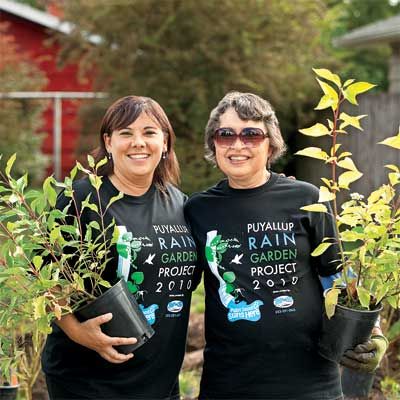
Photo: Organizer Heidi Eshpeter (left) pictured with fellow community-gardener Paula Hemphill
Organizing a Neighborhood Initiative
To start a community rain garden project:
- Connect with local environmental organizations or university extension programs.
- Create a maintenance plan for long-term success.
- Educate neighbors about the benefits of rain gardens.
- Find the funds to create a rain garden through grants or community fundraising efforts.
- Organize volunteer planting days to engage the community.
Benefits of Community Projects
Explain the advantages of a rain garden with community members. Here are a few benefits to share with them:
- Community rain gardens create larger green spaces that support local wildlife and enhance the urban landscape.
- These projects build a sense of community by bringing people together with a common goal of improving the environment.
- Coming together to build a rain garden provides educational opportunities to learn about sustainable landscaping and water management.
Rain Garden Plant List
See below for a complete run-down of the plants used in the community rain-garden project above.
Leather-Leaf Sedge (Carex Buchananii)
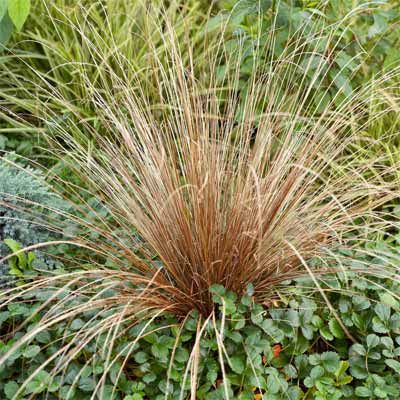
Because the leaf blades match the color of the siding and color matching is the theme, the sedge is front and center.
- Flowers aren’t showy
- Zone 3: Hardy to zero degrees Fahrenheit
- Height: Up to 2 feet
Coastal or Beach Strawberry (Fragaria Chiloensis)
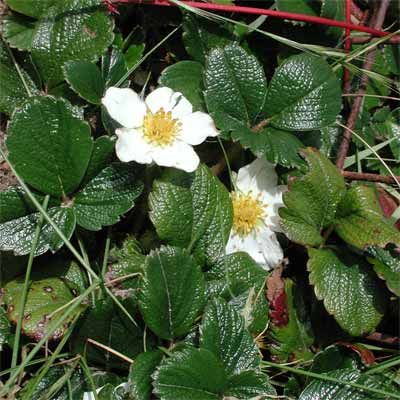
The glossy green leaves of this wild strawberry look attractive year-round. The plant spreads rapidly by runners, so it’s a groundcover here.
- White flowers
- Zone 2 or 3: Hardy to at least 15 degrees Fahrenheit
- Height: Up to 10 inches
Red-Twig Dogwood (Cornus Sericea, syn. C. Stolonifera, Swida Sericea)
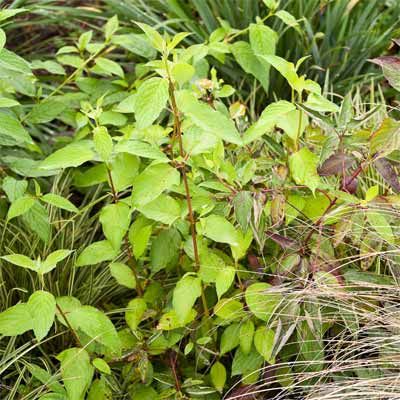
Native to most of the U.S., this deciduous shrub has bright reddish-brown stems in winter. It was planted where it will grow to add privacy to the front window.
- Zone 1 or 2: Hardy everywhere
- Height: 6 to 15 feet
‘Silver Knight’ Heather (Calluna Vulgaris)
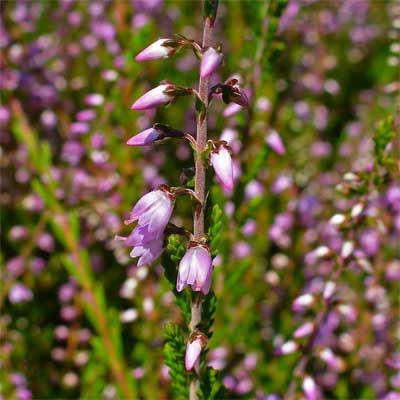
Silver-gray leaves take on a purple cast in winter and are overtaken by sprays of flowers in summer. Lavender flowers.
- Zone 3: Hardy everywhere
- Height: Up to 16 inches
‘Blue Star’ Juniper (Juniperus Squamata)

Hardy conifer produces uniform branches covered with dense, silver-blue foliage.
- No flowers
- Zone: 2: Hardy everywhere
- Height: Up to 3 feet
Compact Oregon Grape (Mahonia Aquifolium ‘Compacta’)
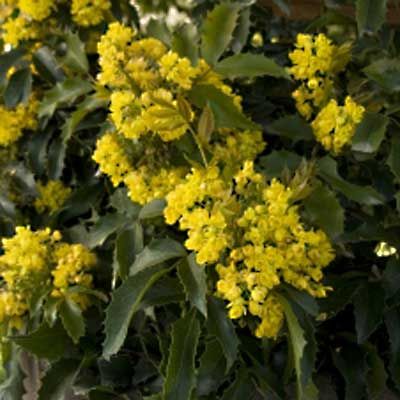
Though most mature leaves on this evergreen shrub are green, new leaves and some mature ones in fall fit the bronze-red color scheme.
- Yellow flowers
- Zone 3: Hardy to minus 20 degrees Fahrenheit
- Height: Up to 3 feet
‘Ice Dance’ Japanese Sedge (Carex Morrowii)
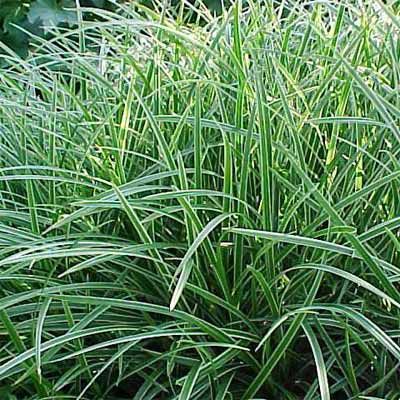
This grasslike plant forms tidy mounds of green blades edged in white.
- Insignificant flowers
- Zone 1: Hardy to minus 30 degrees Fahrenheit
- Height: Up to 12 inches
Yellow-Eyed Grass (Sisyrinchium Californicum)
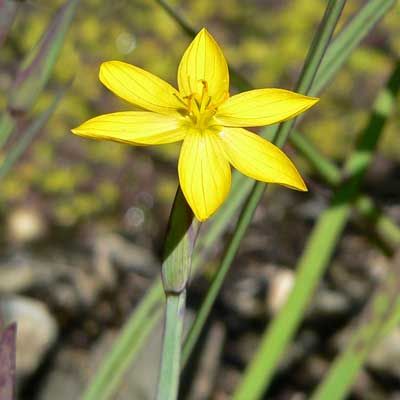
An iris relative, this West Coast native has grasslike leaves and petite flowers that open on sunny days in spring and early summer.
- Yellow flowers
- Zone 1, 2, or 3: Hardy to 10 degrees Fahrenheit
- Height: Up to 12 inches
Snowberry (Symphoricarpos Albus)
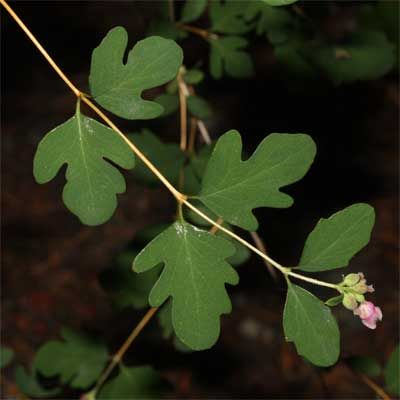
This shrub, native to the western U.S., produces white fruit that stays on even after the leaves drop, attracting birds. The berries are poisonous to humans.
- Pink flowers
- Zone 2 or 3: Hardy everywhere
- Height: Up to 6 feet
Variegated Lily Turf (Liriope Muscari ‘Variegata’)
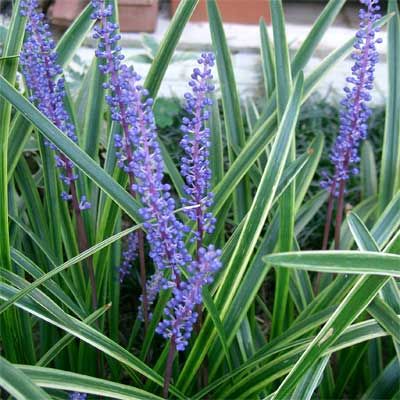
Forming soft clumps of grasslike leaves, lily turf is a good groundcover or edging for a rain garden. The variegated form has green leaves edged in creamy yellow, though the yellow disappears as the leaves age.
- Violet flowers
- Zone 1 or 2: Hardy to minus 30 degrees Fahrenheit
- Height: Up to 20 inches
Mugo Pine (Pinus Mugo)
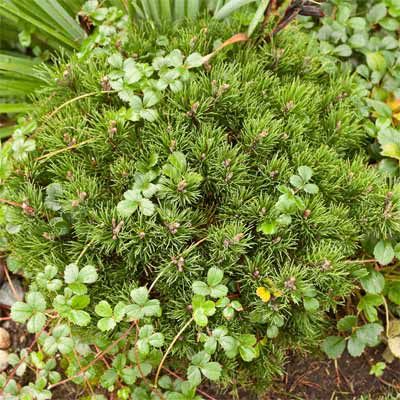
This slow-growing conifer has unusually dense needles. It eventually spreads 15 feet, twice as wide as its mature height, so it’s planted at the back, where it will grow to shelter the house from the street.
Russian Sage (Perovskia Atriplicifolia)
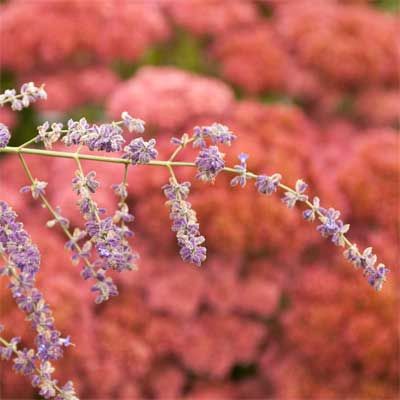
Gray-green leaves and sprays of small flowers add textural contrast among plants with bolder flowers. It’s at the front, where visitors can enjoy its scent as they brush against the leaves.
- Lavender-blue flowers
- Zone 3: Hardy to minus 30 degrees Fahrenheit
- Height: Up to 36 inches
‘Autumn Joy’ Sedum (S. ‘Herbstfreude’)
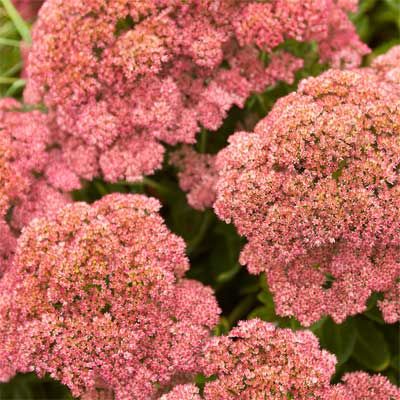
Long-lasting flower clusters make this succulent a standout in a rain garden in late summer and fall. Grown as an accent plant in this garden.
- Pink to rust-colored flowers
- Zone 3: Hardy everywhere
- Height: 1 to 2 feet
Black-Eyed Susan (Rudbeckia Fulgida)

Descended from plants native to the eastern U.S., this showy coneflower blooms in late summer and fall. A perennial that dies back to the ground in winter, it needs plenty of room to spread as the summer progresses.
- Golden yellow flowers with dark centers
- Zone 3: Hardy everywhere
- Height: Up to 3 feet
Low Oregon Grape (Mahonia Nervosa)
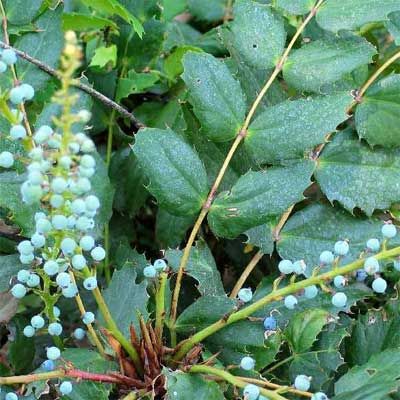
This evergreen shrub has cascades of spiny green leaves most of the year, but in fall many turn fire red. Plant does especially well in shade.
- Yellow flowers
- Zone 2 or 3: Hardy to minus 10 degrees Fahrenheit
- Height: Up to 2 feet
‘Kobold’ Blazing Star (Liatris Spicata)

This eastern U.S. native produces spikes of flower clusters in summer. Adds a nice vertical feature to a relatively dry part of the rain garden. ‘Kobold’ is about half as tall as some selections.
- Rosy lilac flowers
- Zone 3: Hardy to minus 40 degrees Fahrenheit
- Height: Up to 4 feet
Kinnikinnick or Bearberry (Arctostaphylos Uva-Ursi)
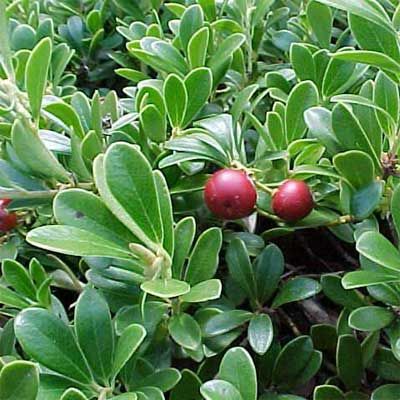
A manzanita relative, this evergreen with small leathery leaves and red berries grows slowly but eventually forms a dense mat that chokes out weeds.
- Rosy lilac flowers
- Zone 3: Hardy to minus 50 degrees Fahrenheit
- Height: Up to 6 inches
Kelsey Dwarf Dogwood (Cornus Sericea ‘Kelseyi’)
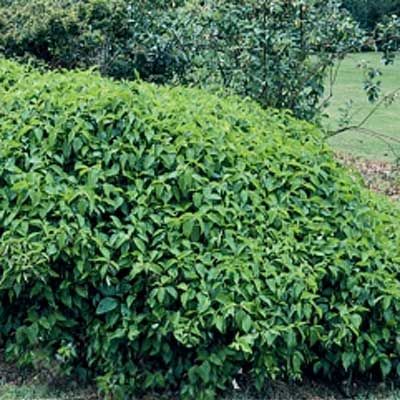
A dwarf form of red-twig dogwood with the same bright-red bark in winter. Berries attract birds.
- White flowers
- Zone 1 or 2: Hardy to minus 50 degrees Fahrenheit
- Height: Up to 30 inches
Tufted Hair Grass (Deschampsia Cespitosa)
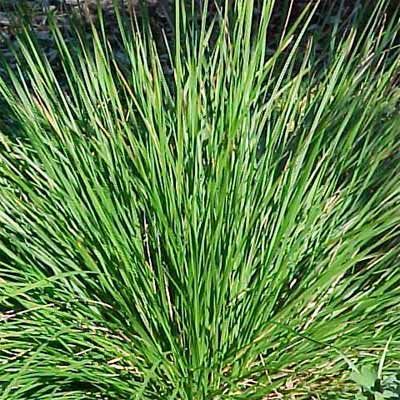
With gracefully cascading thin leaves, airy wands of flowers, and, later, seeds, this perennial bunchgrass stays attractive most of the year.
- Green to greenish-gold flowers
- Zone 1 or 2: Hardy to minus 40 degrees Fahrenheit
- Height: Up to 2 feet
Blue Oat Grass (Helictotrichon Sempervirens)
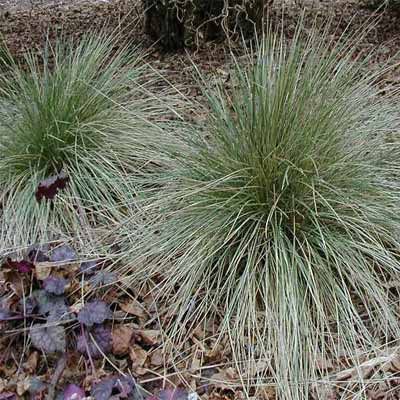
A Mediterranean import, this tidy grass produces a fountain of blue-green leaves. Two clumps dominate the front of the garden.
- Golden flower clusters
- Zone 3: Hardy everywhere
- Height: Up to 3 feet
Evergreen Huckleberry (Vaccinium Ovatum)

With glossy leaves year-round, bell-shaped flowers in spring, and tasty blueberry-type fruit in fall, this shrub, a western U.S. native, is easy to love. But it grows very slowly for the first couple of years, so it’s hardly noticeable.
- White to pink flowers
- Zone 3: Hardy to zero degrees Fahrenheit
- Height: Up to 3 feet in sun or 12 feet in shade, but can be pruned back
Blue Fescue (Festuca Ovina var. Glauca)
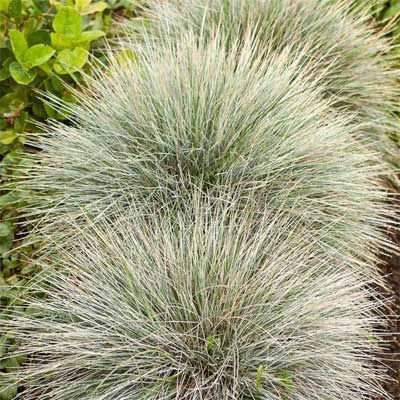
A finely textured, clump-forming grass with wands of buff-colored seeds in late summer and fall. Planted at the far end of the garden.
- Flowers aren’t showy
- Zone 2: Hardy to minus 30 degrees Fahrenheit
- Height: Up to 12 inches
Salal (Gaultheria Shallon)

Popular among florists as a foliage plant, salal is a northwest U.S. native that thrives in sun or shade, and it produces delicious but fuzzy berries as a bonus.
- White to pink flowers
- Zone 3: Hardy to minus 40 degrees Fahrenheit
- Height: Up to 5 feet
Dagger-Leaf or Sword-Leaf Rush (Juncus Ensifolius)
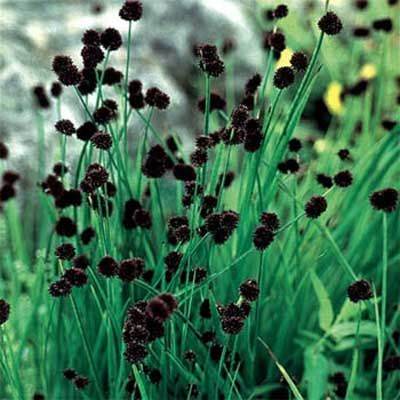
Native to most of the western U.S., this perennial forms dense, grasslike clumps.
- Insignificant flowers
- Zone 1: Hardy to minus 20 degrees Fahrenheit
- Height: Up to about 2 feet
‘Fireglow’ Japanese Maple (Acer Palmatum)
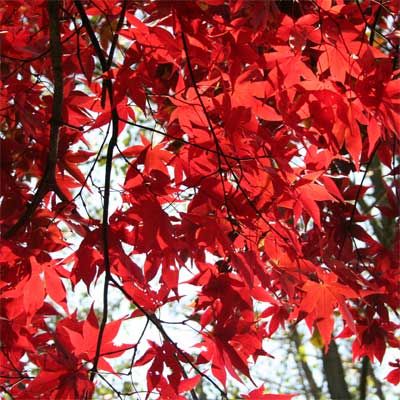
This small tree sends out leaves that are almost purple in spring; they later change to a brilliant crimson. Because the branches will spread, it’s planted toward the center.
- Insignificant flowers
- Zone 2: Hardy to minus 20 degrees Fahrenheit
- Height: Up to 15 feet
Tall Oregon Grape (Mahonia Aquifolium)

Intriguing glossy but spiky leaves turn red in fall and winter. Showy flowers in spring develop into tart, edible berries that look like purple grapes. Grows tall, so it’s at the back.
- Yellow flowers
- Zone 2: Hardy to minus 30 degrees Fahrenheit
- Height: Up to 15 feet
‘Darts Gold’ Ninebark (Physocarpus Opulifolius)
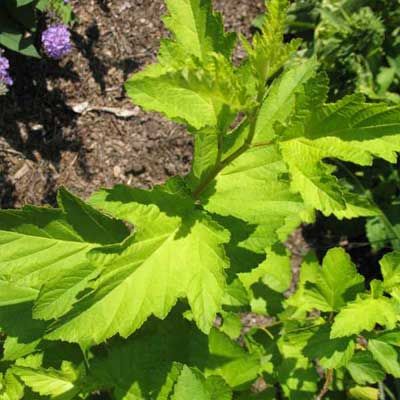
The leaves start out yellow, turn chartreuse by mid-summer, then become yellow or bronze in fall—at every stage, a nice contrast to other plants. The branches are bare in winter, then you notice the peeling bark typical of all ninebarks.
- White flowers
- Zone 1 or 2: Hardy to minus 40 degrees Fahrenheit
- Height: Up to 5 feet
Black Mondo Grass (Ophiopogon Planiscapus ‘Nigrescens’)

This lily is grown for its especially dark, purplish-black leaves. In this garden, the plant is interspersed with blue oat grass to make its leaves seem even bluer. The mondo grass also intensifies the chartreuse of ‘Dart’s Gold’ ninebark.
- White or purplish flowers
- Zone 2 or 3: Hardy to zero degrees Fahrenheit
- Height: Up to 12 inches
Pacific Ninebark (Physocarpus Capitatus)
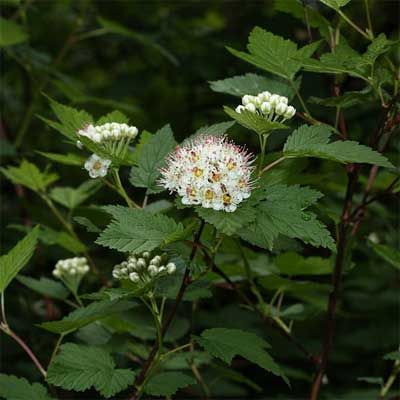
Named for the way it sheds its outer bark in strips to reveal multicolored inner layers, this native shrub of the northwest U.S. also has flowers that look like single roses in spring and interesting red seed pods in fall.
- White flowers
- Zone 1 or 2: Hardy to minus 20 degrees Fahrenheit
- Height: Up to 8 feet
‘Summer Wine’ Ninebark (Physocarpus Opulifolius)
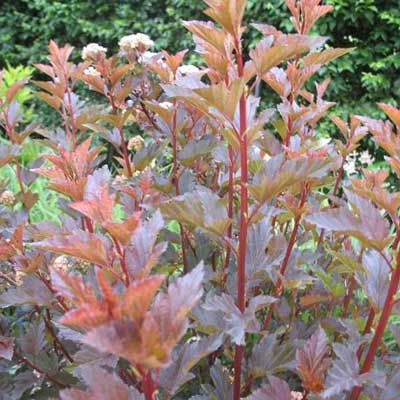
This purple-leaved ninebark is used at each end of this rain garden. It has the same beautiful peeling bark and interesting seed capsules as the standard ninebark.
- Pinkish-white flowers
- Zone 1 or 2: Hardy to minus 40 degrees Fahrenheit
- Height: Up to 6 feet
Slough Sedge (Carex Obnupta)
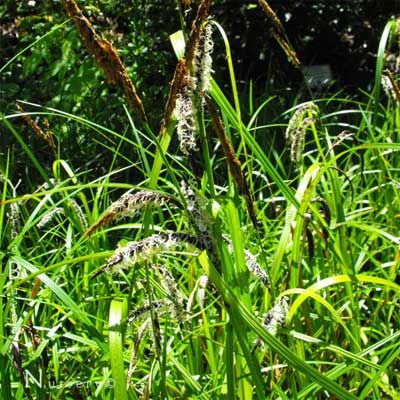
This clump-forming perennial, with grasslike leaves creased down the middle, stays green and lush-looking even when dry. It’s taller than some similar plants, so it’s at the center.
- Insignificant flowers
- Zone 1: Hardy to zero degrees F
- Height: Up to 5 feet
Idaho Fescue (Festuca Idahoensis)
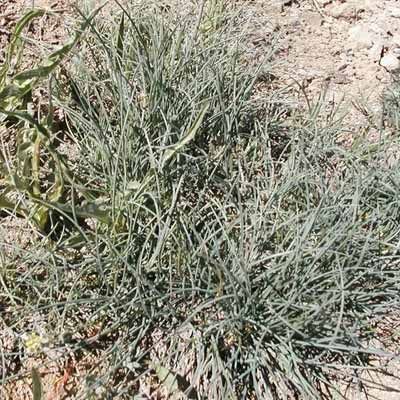
A relatively petite bunchgrass, native to the western U.S., this fescue has thin, bluish-green leaves. It can be planted in a mass to create a meadow look, but in this garden it fills gaps.
- Insignificant flowers
- Zone 2: Hardy everywhere
- Height: Up to 14 inches
Red-Hot Poker (Kniphofia Uvaria)
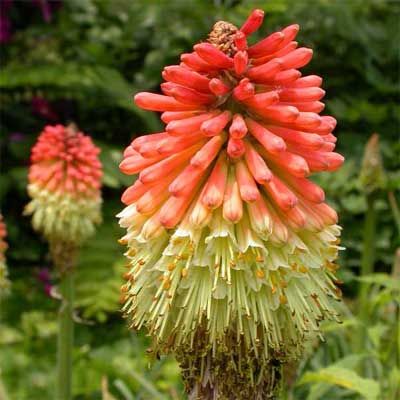
From southern Africa, this lily relative produces large clumps of grasslike leaves topped by flower spikes that resemble glowing pokers for a fire. Hummingbirds love them.
- Red and yellow flowers
- Zone 3: Hardy to minus 30 degrees F
- Height: Up to 5 feet
‘Bumalda’ Spiraea (Spiraea Japonica)
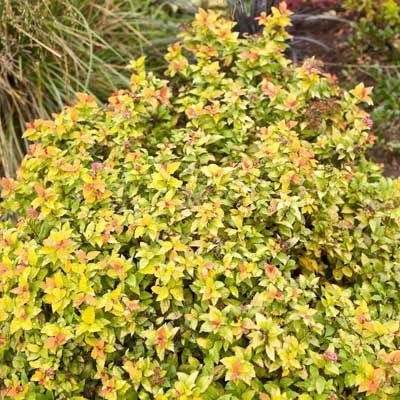
New leaves are tinted bronze on this shrub, which has flat clusters of dark-pink flowers in summer.
- Zone 2: Hardy to minus 40 degrees Fahrenheit
- Height: Up to 3 feet
‘Hidcote’ English Lavender (Lavandula Angustifolia)
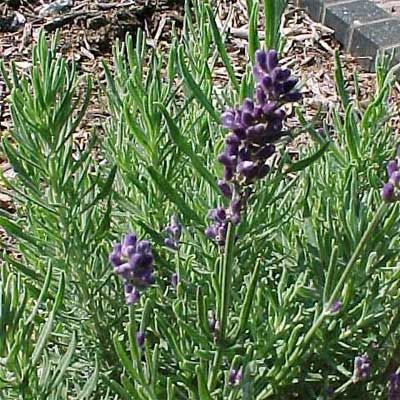
Suitable for flavoring food as well as scenting perfume and sachets, ‘Hidcote’ is easy to grow where the air is dry but more difficult in humid areas. A rain-garden berm makes a good home.
- Deep-purple flowers
- Zone 3: Hardy to minus 20 degrees F
- Height: Up to 18 inches
Dwarf Mugo Pine (Pinus Mugo var. Pumillow)
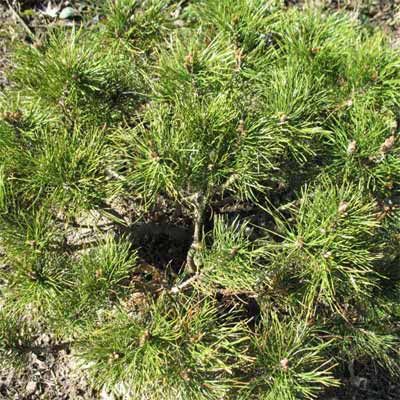
It has the same dense, dark-green needles of standard mugo pine, but grows slowly to only 5 feet.
- No flowers
- Zone 3: Hardy to minus 50 degrees Fahrenheit
‘Moonshine’ Yarrow (Achillea)
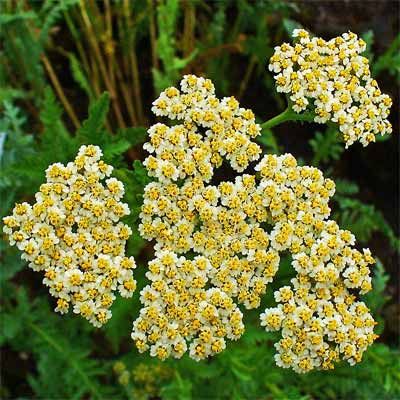
This easy-care yarrow thrives in sunshine and blooms all summer and into fall. It’s planted at the front.
- Zone 3: Hardy to minus 40 degrees Fahrenheit
- Height: Up to 2 feet
‘Stella de Oro’ Daylily (Hemerocallis)
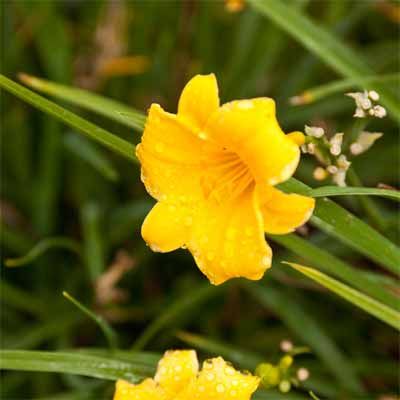
Probably the best-known daylily, this variety pumps out new flowers almost daily all summer, so it’s along the side of the rain garden closest to where people walk up to the front door.
- Yellow flowers
- Zone 3: Hardy to minus 40 degrees Fahrenheit
- Height: Up to 2 feet
Nepeta (N. x Faassenii)
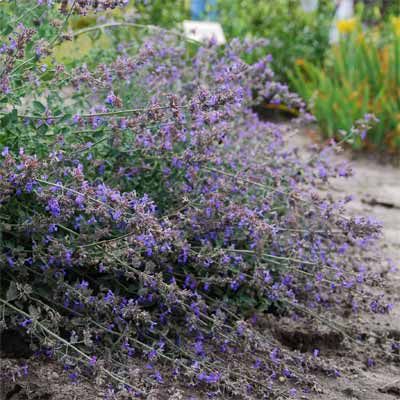
This mint produces billowing spikes of blue flowers, a nice contrast to the yellow-flowering plants nearby. Most mints reseed freely, so if you don’t want new plants springing up, cut back spent blossoms promptly or plant a sterile kind, such as catmint.
- Blue flowers
- Zone 3: Hardy everywhere
- Height: Up to 4 feet
Purple Coneflower (Echinacea Purpurea)
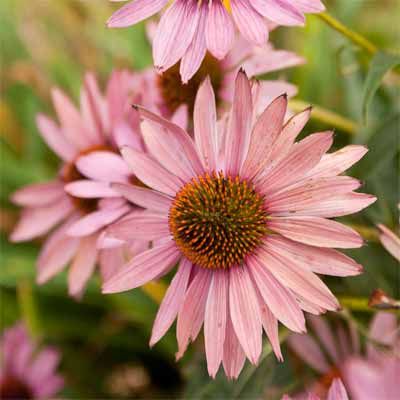
A perennial, this plant produces daisy-like flowers with dark centers from late June into fall. The steps are tall, so the three clumps of this plant are at the back.
- Purplish-pink flowers
- Zone 3: Hardy to minus 40 degrees Fahrenheit
- Height: Up to 4 feet
Mexican Feather Grass (Nassella Tenuissima)
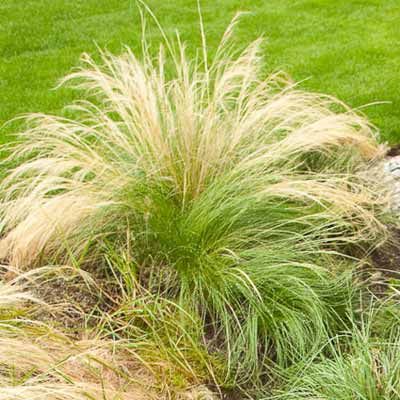
This grass attracts attention because of its airy seed heads and thread-like leaves in an unusual blond color. In this rain garden, it’s planted where its cascading form contrasts with the stiffer, more upright blades of blue oat grass. Can be invasive.
- Silvery-green seed heads
- Zone: Hardy to minus 20 degrees Fahrenheit
- Height: Up to 2 feet
Japanese Blood Grass (Imperata Cylindrica ‘Rubra’)
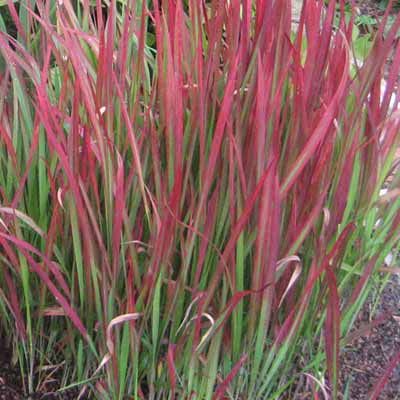
The spiky leaves of this clump-forming grass are green at the base but transition halfway up to vibrant red. This cultivar rarely flowers, so it isn’t invasive.
- Zone: Hardy to minus 30 degrees Fahrenheit
- Height: Up to 18 inches
Heavenly Bamboo (Nandina Domestica)
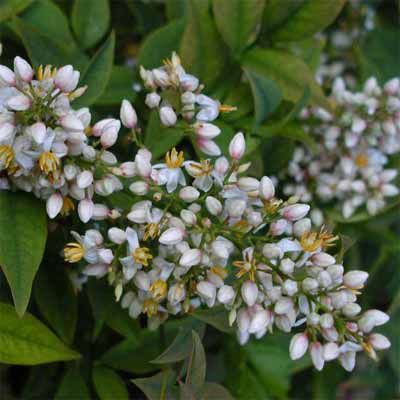
Unrelated to standard bamboo but with a leaf pattern that looks somewhat similar, this evergreen shrub turns red in fall.
- White flowers
- Zone: Hardy to minus 10 degrees Fahrenheit
- Height: Up to 8 feet
‘Little Bunny’ Dwarf Fountain Grass (Pennisetum Alopecuroides)

This finely textured grass is topped with fluffy flower heads that wave in the breeze, as if bunnies were hopping.
- Whitish flower plumes
- Zone 3: Hardy to minus 20 degrees Fahrenheit
- Height: Up to 18 inches
